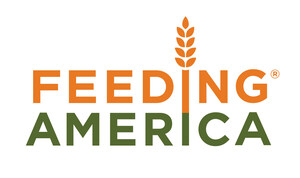CHICAGO, March 9, 2021 /PRNewswire/ -- Feeding America today released its initial food insecurity projections for 2021 that show approximately 42 million people—one in eight individuals in America—could experience food insecurity in 2021 due to the ongoing economic fallout from COVID-19. The study also reveals that many people who have been most impacted by the pandemic were food insecure or at risk before the pandemic and are facing greater hardship now.
"Before the pandemic, every community in the U.S. was home to people facing hunger, and unfortunately that continues to be true. We find that to be unacceptable," said Claire Babineaux-Fontenot, CEO of Feeding America. "In the last year, the Feeding America network of food banks distributed 6.1 billion meals to families, individuals, children and seniors in need, but if we are to achieve our vision of an America where no one is hungry, then we – the collective we – must do more."
The study, The Impact of the Coronavirus on Food Insecurity in 2020 and 2021, provides a snapshot of food insecurity at the national level leading up to the pandemic, what transpired in the first year, and what may happen in the next year and beyond. To understand how COVID-19 has impacted the need for food in the United States, Feeding America in partnership with Dr. Craig Gundersen leveraged their annual Map the Meal Gap study, which estimated local food insecurity, to predict food insecurity using projected changes to variables in that model—namely annualized poverty rates and unemployment rates.
In March 2020, when cities and states issued stay-at-home mandates and closures of non-essential businesses to curb transmission rates of the virus, those mitigations resulted in the first economic recession in the U.S. since 2007. The entire Feeding America network of 200 food banks and 60,000 partner food pantries and meal programs saw an immediate influx of people turning to them for help. As such, Feeding America projects that 10 million more people could have experienced food insecurity in 2020, up from 35 million in 2019.
Key Findings for 2021:
- Feeding America projects that 42 million people (1 in 8), including 13 million children (1 in 6), may experience food insecurity in 2021.
- Among them, Feeding America projects that 15 million people, including nearly 4 million children, may experience very low food security, a more severe level of food insecurity characterized by reduced food intake and disrupted eating patterns.
- Significant racial disparities in food insecurity, which existed prior to the pandemic, remain today.
- Prior to the pandemic, data showed that in the U.S. food insecurity among Native Americans, Black people and Latinos was 2-3 times higher than for non-Hispanic white individuals.
- Feeding America projects that 21% of Black people (1 in 5) may experience food insecurity in 2021, compared to 11% of white people (1 in 9).
"While COVID-19 has proven to be an enduring crisis, it has also demonstrated the collective empathy and generosity of people in our country to help their neighbors when they need it most," Babineaux-Fontenot said. "We are proud of what the Feeding America network has accomplished together, but we need to accelerate our work to address disparities and advance solutions to reach people and communities that have been inordinately impacted by food insecurity including rural communities and communities of color."
Though economic fallout from the pandemic continues, improvements in the economy, federal response and the work of the charitable food network have played a significant role in mitigating the food crisis. In the past year, the Feeding America network distributed 6.1 billion meals. Feeding America deployed $326 million in grants to food banks to support food acquisition when the supply chain was disrupted, food distributions and home deliveries of meals. On March 4, 2021, Feeding America also established the Food Security Equity Impact Fund to drive investments to communities of color known to be disproportionately impacted by food insecurity and the COVID-19 pandemic.
Prior COVID-19 Congressional and Administrative actions led to more, vital resources being available to individuals who need food assistance. As the American Rescue Plan Act of 2021 moves forward this week to a final House vote and then President Biden's signature, this additional support will help further mitigate the economic crisis.
Babineaux-Fontenot added, "We know that a strong, continued federal response is critical to meet the challenges and needs of the time. We also look forward to continuing to work with policymakers on the additional investments needed to address food insecurity as we continue the path to recovery."
Feeding America will continue monitoring the economic outlook and release revised projections whenever there are significant changes to the underlying assumptions, such as projected unemployment and poverty rates for the year.
After the Great Recession of 2007, it took 10 years for food insecurity levels to recover to pre-Recession levels. It is likely to take time for food insecurity levels to recover from this recession as well. Families, individuals and seniors will need continued support from the government, the private sector and the charitable food system to get through these crises.
To join and learn more about Feeding America's COVID-19 response efforts, visit feedingamerica.org/covid19.
About Feeding America
Feeding America® is the largest hunger-relief organization in the United States. Through a network of 200 food banks and 60,000 food pantries and meal programs, we provide meals to more than 40 million people each year. Feeding America also supports programs that prevent food waste and improve food security among the people we serve; educates the public about the problem of hunger; and advocates for legislation that protects people from going hungry. Visit www.feedingamerica.org, find us on Facebook or follow us on Twitter.
Contact
Zuani Villarreal
Feeding America
312.641.6532
SOURCE Feeding America
Related Links
WANT YOUR COMPANY'S NEWS FEATURED ON PRNEWSWIRE.COM?
Newsrooms &
Influencers
Digital Media
Outlets
Journalists
Opted In





Share this article